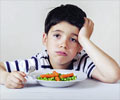Children exposed to higher levels of pesticide found on commercially grown fruit and vegetables in the United States were more likely to have attention deficit/hyper-activity disorder,

"The present study adds to the accumulating evidence linking higher levels of pesticide exposure to adverse developmental outcomes," the study concluded.
Roughly 40 organophosphate pesticides are registered with the US Environmental Protection Agency for use in the United States, and around 73 million pounds of the pesticides were used in agricultural and residential settings in 2001, figures cited in the study said.
Although residential pesticide use is common, the National Academy of Sciences found that the major source of exposure for infants and children comes through the diet, the study added.
According to a 2008 report cited by the study, detectable levels of pesticides were found in a range of vegetables. A sample of produce tested found 28 percent of frozen blueberries, 20 percent of celery and 25 percent of strawberries contained traces of one organophospate, know as malathion.
Other types of pesticides were found in 27 percent of green beans, 17 percent of peaches, and eight percent of broccoli.
Advertisement
Source-AFP
SRM















